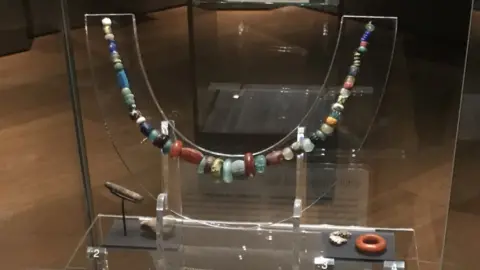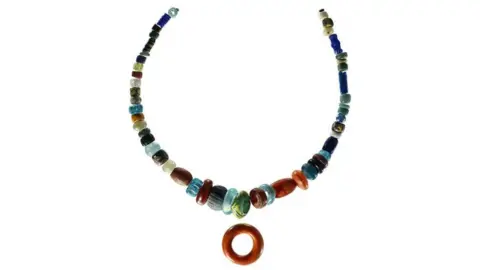'Pagan sorceress' Viking necklace on display in York
 MNH
MNHA "stunning" piece of Viking jewellery worn by a "pagan sorceress" found at Peel Castle, has gone on display off the island for the first time.
The 1,000-year-old necklace was found during an archaeological dig on St Patrick's Isle in Peel in 1984.
The decorative piece is made up of 51 colourful glass, jet and amber beads.
It has been put on show at Jorvik Visitor Centre in York as part of an exhibition focusing on Viking women.
Marketing manager Beth Dawes said the centre was "really thrilled" to have the piece on loan from Manx National Heritage (MNH).
 MNH
MNH"It is absolutely beautiful. I've been saying that I would wear it myself," she said.
"The grave that the necklace was found in indicated that the woman might have been a pagan sorceress… which was a shaman sort of person who would have told fortunes and been very involved in rituals and religion."
Spiritual link
The woman is known as the 'Pagan Lady' because, although the Vikings held pagan beliefs, she was buried in a Christian cemetery.
Curator of Archaeology for MNH, Allison Fox, said the grave was "by far the wealthiest female burial" to be found on the island to date.
"The very least we can say is that she was a very important woman in the local community, and that importance might have a spiritual connotation as well as a practical domestic side," Ms Fox said.
"The number and variety of beads is really the striking thing about the necklace, that makes it stand out," she added.
 Dave Kneale
Dave KnealeThe grave dates back to 950 AD, although it is thought some of the beads are 400 years older than that.
The burial also contained other grave goods including a fossil ammonite charm and a miniature pestle and mortar.
The necklace, which has been on display in the Manx Museum since its discovery, will be on show in York until August 2019.
